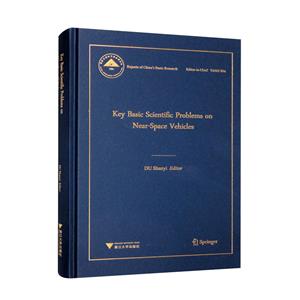-
>
湖南省志(1978-2002)?铁路志
-
>
公路车宝典(ZINN的公路车维修与保养秘籍)
-
>
晶体管电路设计(下)
-
>
基于个性化设计策略的智能交通系统关键技术
-
>
德国克虏伯与晚清火:贸易与仿制模式下的技术转移
-
>
花样百出:贵州少数民族图案填色
-
>
识木:全球220种木材图鉴
Key basic scientific problems on near-space vehicles 版权信息
- ISBN:9787308227612
- 条形码:9787308227612 ; 978-7-308-22761-2
- 装帧:一般胶版纸
- 册数:暂无
- 重量:暂无
- 所属分类:>
Key basic scientific problems on near-space vehicles 内容简介
As Lao Tzu said,"A huge tree grows from a tiny seedling a nine-storied tower rises from a heap of earth." Basic research is the fundamental approach to fostering innovation-driven development,and its level becomes an important yardstick for measuring the overall scientific and national strength of a country. Since the beginning of the 21st century,China's overall strength in basic research has been consistently increasing. With respect to input and output,China's input in basic research increased by 14.8 times from 5.22 billion yuan in 2001 to 82.29 billion yuan in 2016,with an average annual increase of 20.2%. In the same period,the number of China's scientific papers included in the Science Citation Index (SCI)increased from lower than 40,000 to 324,000;China rose from the 6th to the 2nd place in global ranking in terms of the number ofpublished papers. In regard to the quality of output,in 2016,China ranked No. 2 in the world in terms of citations in 9 disciplines,among which the materials science ranked No. 1;as of October 2017,China ranked No. 3 in the world in the numbers of both Highly Cited Papers (top 1%) and Hot Papers (top 0.1%),with the latter accounting for 25.1% of the global total. In talent cultivation,in 2006,China had 175 scientists (136 ofwhom from the Chinese mainland) included in Thomson Reuters' list of Highly Cited Researchers,ranking 4th globally and lst in Asia.Meanwhile,we should also be keenly aware that China's basic research is still facing great challenges. First,funding for basic research in China is still far less than that in developed countries-only about 5% of the R&D funds in China are used for basic research,a much lower percentage than 15%-20% in developed countries. Second,competence for original innovation in China is insufficient.Major original scientific achievements that have global impact are still rare. Most of the scientific research projects are just a follow-up or imitation of existing research,rather than groundbreaking research. Third,the development of disciplines is not balanced,and China's research level in some disciplines is noticeably lower than the international level-China's Field-Weighted Citation Impact (FWCI) in disciplines just reached 0.94 in 2016,lower than the world average of 1.0.Lao Tzu said, "A huge tree grows from a tiny seedling; a nine-storied tower rises from a heap of earth." Basic research is the fundamental approach to fostering innovation-driven development, and its level becomes an important yardstick for measuring the overall scientific and national strength of a country. Since the beginning of the 21st century, China's overall strength in basic research has been consistently increasing. With respect to input and output, China's input in basic research increased by 14.8 times from 5.22 billion yuan in 2001 to 82.29 billion yuan in 2016, with an average annual increase of 20.2%. In the same period, the number of China's scientific papers included in the Science Citation Index (SCI)increased from lower than 40,000 to 324,000; China rose from the 6th to the 2nd place in global ranking in terms of the number ofpublished papers. In regard to the quality of output, in 2016, China ranked No. 2 in the world in terms of citations in 9 disciplines, among which the materials science ranked No. 1; as of October 2017,China ranked No. 3 in the world in the numbers of both Highly Cited Papers (top 1%) and Hot Papers (top 0.1%), with the latter accounting for 25.1% of the global total. In talent cultivation, in 2006, China had 175 scientists (136 ofwhom from the Chinese mainland) included in Thomson Reuters' list of Highly Cited Researchers,ranking 4th globally and lst in Asia.Meanwhile, we should also be keenly aware that China's basic research is still facing great challenges. First, funding for basic research in China is still far less than that in developed countries-only about 5% of the R&D funds in China are used for basic research, a much lower percentage than 15%-20% in developed countries. Second, competence for original innovation in China is insufficient.Major original scientific achievements that have global impact are still rare. Most of the scientific research projects are just a follow-up or imitation of existing research,rather than groundbreaking research. Third, the development of disciplines is not balanced, and China's research level in some disciplines is noticeably lower than the international level-China's Field-Weighted Citation Impact (FWCI) in disciplines just reached 0.94 in 2016, lower than the world average of 1.0.
Key basic scientific problems on near-space vehicles 作者简介
近空间飞行器的关键基础科学问题项目组,项目组组长为杜善义。中国工程院院士,力学和复合材料专家。长期从事飞行器结构力学和复合材料的教学及科研工作。
- >
推拿
推拿
¥12.2¥32.0 - >
大红狗在马戏团-大红狗克里弗-助人
大红狗在马戏团-大红狗克里弗-助人
¥5.1¥10.0 - >
中国人在乌苏里边疆区:历史与人类学概述
中国人在乌苏里边疆区:历史与人类学概述
¥36.0¥48.0 - >
罗庸西南联大授课录
罗庸西南联大授课录
¥13.8¥32.0 - >
经典常谈
经典常谈
¥28.3¥39.8 - >
随园食单
随园食单
¥15.4¥48.0 - >
史学评论
史学评论
¥23.2¥42.0 - >
姑妈的宝刀
姑妈的宝刀
¥13.5¥30.0
-
迷蒙星空-探天之路
¥14.5¥39 -
飞天起航
¥13.9¥35 -
航空工业出版社遥控模型飞机系列遥控像真模型飞机入门
¥20.2¥48 -
航天器自主导航技术
¥39.1¥112 -
国家出版基金 中国航天的历史使命
¥22.8¥68 -
航空超高强度钢的发展
¥25.9¥58




















